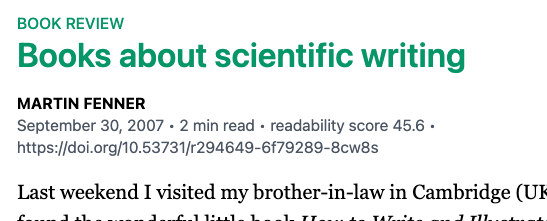Readability is the ease with which a reader can understand a written text. – Wikipedia
Readability is obviously important for any kind of scholarly communication, from writing papers to blog posts. I have written about scientific writing before (e.g. Scientific writers can help publish good papers, Books about Science Writing, Do you know the Flesch score of your papers?), and writing scholarly content that is understandable is something that can be taught and learned.
Something simple that can help is providing feedback in the form of readability scores, generated automatically with formulas that for example use the average sentence length (ASL) and average number of syllables per word (ASW), as in the Flesch Reading Ease score first published in 1948:
206.835 - 1.015 x ASL - 84.6 x ASW
The score can be anywhere between 0 and 100, with a higher scores meaning better readability.
| Score | Notes |
|---|---|
| 90-100 | very easy to read, easily understood by an average 11-year-old student |
| 80-90 | easy to read |
| 70-80 | fairly easy to read |
| 60-70 | easily understood by 13- to 15-year-old students |
| 50-60 | fairly difficult to read |
| 30-50 | difficult to read, best understood by college graduates |
| 0-30 | very difficult to read, best understood by university graduates |
The Flesch Reading Ease score has been researched extensively, with a particular influence on journalism, showing that higher scores can increase readership.
Many writing tools have the Flesch Reading Ease score built in, including Microsoft Word and Grammerly. And there are open source libraries in a number of languages. This week the Front Matter blog started calculating and displaying the Flesch Reading Ease score (readability score for short) using the readability-cyr javascript library. You can see the score in the byline at the top of individual posts, or in listings of blog posts.

I will do a more systematic analysis at some point (the numbers are in our database index), for now I will highlight the Front Matter posts with the highest and lowest readability scores:
- Having an impact (factor) and other stories from Gregory Petsko 72.3
- More Gobbledygook at PLoS Blogs 71.3
- Researchers’ reasons for publishing their work 70.5
- ...
- We need your feedback: Aligning the CodeMeta vocabulary for scientific software with schema.org 17.0
- German Genetics Society Meeting 2009: Session VI 14.6
- Neelie Kroes talks Open Science 12.3
Most posts have a score between 30 and 50, lower than most newspapers and novels, but higher than highly specialized scientific papers. Blog posts that have a score much higher or lower are particularly interesting, as we might learn something that can improve our writing. But take the readability score with a grain of salt, as other factors not really in our control might influence the score.
P.S. This post has a readability score of 52.4.


